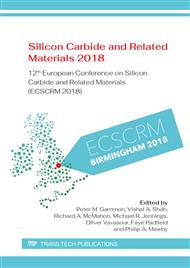p.516
p.520
p.525
p.530
p.539
p.544
p.549
p.553
p.558
Study of 4H-SiC Superjunction Schottky Rectifiers with Implanted P-Pillars
Abstract:
This paper discusses the study of 4H Silicon Carbide (4H-SiC) Schottky rectifier structures based on the superjunction (SJ) principle. The effects of device geometry have been investigated to optimise the trade-off between breakdown voltage (VBD), specific on-resistance (RON,SP), and the ion-implantation fabrication window, so ensuring the final design is practically realisable. In this study, both full-SJ and semi-SJ (SSJ) layouts improve the VBD-RON,SP trade-off to below the 4H-SiC unipolar limit. In comparison to a conventional planar Schottky diode, full SJ structures, with p-pillars that traverse the full length of the n-drift region, have a 7x improvement in RON,SP for a 50-100 V reduction in VBD. In comparison, the SSJ structure is composed with the combination of the SJ structure and an n-bottom assist layer (BAL), which adds 2-μm of n-drift below the SJ pillars. The SSJ structure demonstrates a 5x improvement in RON,SP for a 300 V increase in VBD, for the same aspect ratio. Most favourably, the SSJ structure also has an ion-implantation processing window 60% higher than the full SJ device, offering better anti-charge-imbalance characteristics. In both full and semi layouts, a trench sidewall angled (α) at 80o was considered optimal, resulting in a slightly higher VBD and RON,SP, and a wider processing window, compared to vertical (90o) sidewalls.
Info:
Periodical:
Pages:
539-543
Citation:
Online since:
July 2019
Keywords:
Price:
Сopyright:
© 2019 Trans Tech Publications Ltd. All Rights Reserved
Share:
Citation:


